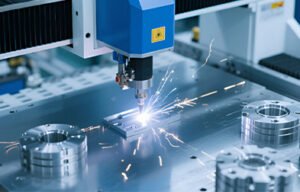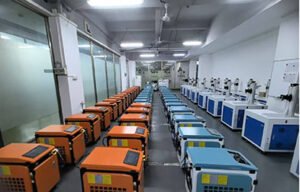- Home
- »
- Uncategorized
- »
- Efficient Mold …
BLOG
CONTACT US
Efficient Mold Repair Without Replacing the Entire Mold – Laser Welding Is the Solution
1. Introduction: The Hidden Cost of Mold Replacement
For manufacturers, especially in industries like automotive, plastics, and electronics, molds are one of the most expensive and valuable assets. When defects appear—cracks, porosity, worn edges—the default reaction may be to replace the entire mold. However, replacing a mold can cost tens of thousands of dollars and result in weeks of production downtime.
Fortunately, laser welding for mold repair provides a faster, more cost-effective alternative. It enables pinpoint repairs without the need to scrap the entire tooling, making it the preferred choice for many global manufacturers.
2. What Is Laser Welding for Mold Repair?
Laser welding is a non-contact welding method that uses a focused laser beam to melt and fuse materials at specific points. For mold repair, it allows operators to fill cracks, rebuild edges, or resurface damaged areas with micrometer-level precision.
Unlike traditional methods like arc welding, laser welding generates minimal heat, reducing the risk of thermal distortion or damage to adjacent areas. This makes it ideal for high-precision tools and dies, especially those made from hardened steel or alloy materials.
3. Common Mold Defects and How Laser Welding Fixes Them
Laser welding can efficiently repair a wide range of mold defects, including:
Cracks and Fractures: Welded seamlessly with added material
Surface Pitting or Porosity: Filled in and re-machined for smoothness
Worn Parting Lines: Restored to original tolerances
Chipped Edges or Corners: Reconstructed with precise buildup
Scratches or Indentations: Repaired without affecting mold geometry
Thanks to the high precision of laser welders, mold repairs are practically invisible after post-processing such as polishing or EDM.
4. Benefits of Using Laser Welding for Mold Maintenance
Laser welding brings a series of benefits over traditional mold repair techniques:
Cost Savings: Avoid the expense of new mold manufacturing
Minimal Downtime: Most repairs completed within hours
Precision Control: Accuracy down to 0.1mm or better
No Thermal Damage: Localized heating prevents deformation
Extended Mold Life: Repaired molds often return to full capacity
Repeatable Results: CNC-controlled welding ensures consistency
This approach allows manufacturers to maximize the lifecycle of molds while maintaining high product quality.
5. Comparison: Laser Welding vs Traditional Repair Methods
| Feature | Laser Welding | Traditional Welding |
|---|---|---|
| Heat Input | Low | High |
| Accuracy | High | Moderate |
| Risk of Distortion | Minimal | High |
| Processing Time | Short | Long |
| Repair Quality | Precise | Variable |
| Reusability of Mold | Very High | Moderate |
The results clearly show that laser mold welding offers significant advantages for modern manufacturing.
6. Industries That Benefit from Laser Mold Repair
Laser welding is widely used across industries that rely on precision molds:
Automotive: Engine parts, bumper molds, lighting housings
Plastic Injection Molding: High-volume consumer goods molds
Aerospace: Composite and metal forming tools
Medical Devices: Surgical tool molds, diagnostic equipment
Electronics: Connector and casing molds
Die Casting: Aluminum and zinc casting tools
These sectors require high uptime and tight tolerances, making laser welding essential for mold longevity.
7. Best Laser Welding Machines for Mold Repair
When selecting a laser welding machine for mold repair, key factors to consider include:
Power Output: Typically between 60W–300W for mold work
Wavelength: Fiber lasers are ideal for precision
Control Interface: Touchscreen and programmable CNC features
Cooling System: Efficient water cooling prolongs machine life
Microscope or Camera Assist: Helps operators ensure accuracy
Some recommended models include fiber laser mold welders with 4-axis motion and pulse welding capabilities, designed for fine, localized repair.
8. How to Ensure Precision and Safety in Mold Repair
While laser welding is highly accurate, the following best practices enhance results:
Clean the Mold Surface: Remove oil, rust, or debris before welding
Use Matching Filler Materials: Match hardness and composition
Control Laser Parameters: Optimize pulse duration, frequency, and power
Wear Proper Eye Protection: Laser-safe goggles are essential
Post-Processing: Polishing and machining to restore original shape
Well-trained operators and high-quality equipment ensure safe and effective repair every time.
9. Case Study: Successful Mold Repair with Laser Welding
A global plastic component manufacturer encountered edge wear on a mold used for high-volume connector production. Replacing the mold would have cost $18,000 and delayed production by 3 weeks. Instead, they opted for laser mold repair, completing the process in 24 hours at a cost of less than $2,000.
Post-weld inspection showed no loss of dimensional accuracy, and the mold continued running for another 150,000 cycles before requiring further maintenance. The repair paid for itself many times over.
10. Final Thoughts: Maximize Mold Life with Laser Technology
Mold damage no longer means starting from scratch. With advanced laser welding technology, manufacturers can quickly restore defects, save costs, and keep production lines moving. Whether you operate in automotive, plastic molding, or electronics, investing in laser welding for mold repair is a smart move toward efficient, sustainable production.
111-1024x458.png)


